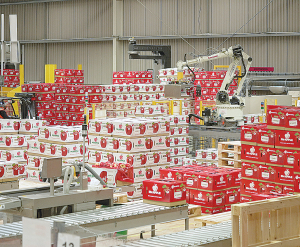US tariffs threaten NZ horticulture exports
"Unwelcome" is how the chief executive of the Horticulture Export Authority (HEA), Simon Hegarty, describes the 15% tariff that the US has imposed on primary exports to that country.
 The Horticulture Export Authority says non-tariff trade measures continue to remain a problem for exporters.
The Horticulture Export Authority says non-tariff trade measures continue to remain a problem for exporters.
Non-tariff trade measures (NTM) remain a problem for NZ exporters, according to Horticulture Export Authority (HEA) chief executive Simon Hegarty.
The HEA released its latest report on 'Barriers to NZ's Horticulture trade'. The 235-page report, produced by the HEA every two years, is effectively an encyclopaedia of what has happened and is likely to happen in the sector.
Hegarty says while existing trade barriers cost the sector around $135 million a year, it's the NTMs that are causing NZ real grief on a daily basis.
Hegarty says these include overly complex regulations and the lengthy time taken by some countries to process an application for a new product to enter their market. Other barriers include compliance around phytosanitary requirements, product labelling, pre-shipment inspections and just getting goods cleared through customs, to name a few.
He says there are other headwinds facing the sector 10-15 days longer to get to Europe and that is disrupting the whole global shipping schedules," he says.
Hegarty says NZ is an isolated nation which struggles to attract freight providers because some of the routes to and from Asia to Europe and the USA are more lucrative.
On the other hand, he says NZ is benefiting from the recent NZ/EU FTA which came into force this year; the removal of tariffs resulted in a $27 million dollar benefit. Other FTAs in the Middle East also had a positive impact, he says.
The HEA report shows that horticulture exports for 2024 were worth $4.9 billion - up just 2% on 2022. But the report notes that this growth in dollar terms came at a time when the actual volume of exports declined by 11%.
Hegarty says kiwifruit and apples make up 77% of horticulture's export revenue with onions coming in third place. He says China is the biggest buyer of our products, followed by the EU, Japan and Australia.
Meanwhile, like other sectors, horticulture is also finding it a challenge to secure a trade deal with India.
NZ hort exports to India amount to just over $78 million - mainly apples but also some kiwifruit. The trouble is apple exports attract a 50% tariff and kiwifruit 30% which cuts into profit margins.
In the past week, a delegation of horticulture exporters (no politicians) representing kiwifruit, apples and pears, onions, avocados, the HEA and others have been in India. Their objective is a reconnaissance mission to get a better handle on the opportunities there, the logistics of increasing our market share and getting a first-hand understanding of how India does business.
Acclaimed fruit grower Dean Astill never imagined he would have achieved so much in the years since being named the first Young Horticulturist of the Year, 20 years ago.
The Ashburton-based Carrfields Group continues to show commitment to future growth and in the agricultural sector with its latest investment, the recently acquired 'Spring Farm' adjacent to State Highway 1, Winslow, just south of Ashburton.
New Zealand First leader and Foreign Affairs Minister Winston Peters has blasted Fonterra farmers shareholders for approving the sale of iconic brands to a French company.
A major feature of the Ashburton A&P Show, to be held on October 31 and November 1, will be the annual trans-Tasman Sheep Dog Trial test match, with the best heading dogs from both sides of the Tasman going head-to-head in two teams of four.
Fewer bobby calves are heading to the works this season, as more dairy farmers recognise the value of rearing calves for beef.
The key to a dairy system that generates high profit with a low emissions intensity is using low footprint feed, says Fonterra program manager on-farm excellence, Louise Cook.